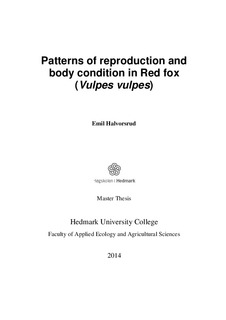Patterns of reproduction and body condition in Red fox (Vulpes vulpes)
Master thesis
Permanent lenke
http://hdl.handle.net/11250/285498Utgivelsesdato
2014Metadata
Vis full innførselSamlinger
Sammendrag
Scandinavian red fox populations are commonly considered to be driven by the cyclicity of small rodent populations. It was recently suggested that the red fox’ general dependency of voles is becoming less pronounced due to larger availability of alternative food resources. Several factors has been suggested to increase red fox' carrying capacities. In my study I explored current patterns in age, sex, reproduction, body condition and morphometrics in relation to abundance of food and population densities. I also investigated possible selective effects of hunting by baiting.
My study area consisted of six municipalities in Hedmark County, Norway, and comprised significant divergences in landscape productivity and altitude. I autopsied 106 red foxes killed between January and April, 2012.
The majority of red foxes autopsied were shot at bait hunting stations. Most of them were killed during March and the sex ratio was not different from 1:1. A large proportion of the foxes were juveniles and there were more juvenile males than females. Males were significantly heavier and larger than females, but with no differences in weight and length between adults and juveniles.
Bait hunting tended to select for individuals with high body condition and the average number of embryos were higher in individuals shot outside bait stations. Females had a significantly higher body condition than males and barren females a higher body condition than non-barren females. Body condition in males was positively correlated to abundance of small rodents the previous autumn. The distribution of adult females decreased with increasing fox abundance.
Autopsied red foxes were mostly in average condition with low variation in body fat. The relatively small proportion of reproducing females, along with an increased body condition of males shot at bait stations compared to other hunting methods, indicates a food limited fox population.
Furthermore, to understand the potential management options possible to reduce the threats to other species, and the potential cascade effects by promoting new assemblages of species in different ecosystems, I stress the importance of continued monitoring of the red fox.
Beskrivelse
Master i anvendt økologi, Evenstad 2014
